BY DOUGLAS HARTPHOTOS BY BEN FREEMAN There is a famous fable from the UK northern-soul scene, from around the time the skinhead look first became popular in about 1969 or 1970. Legend has it that during some unknown all-nighter, at some unknown Manchester club, the fire doors suddenly burst open and a gang of skins piled in. Everyone stopped dancing and waited for the trouble to kick off. The leader of the gang, resplendent in a cashmere Crombie and Levi’s with turnups meticulously measured to one inch sitting neatly and exactly three quarters of an inch above his dark brown Loakes brogues, jumped up on one of the tables and announced that they had come to “smite the philistines that were wearing the wrong clothes, and that they would be paying special attention to those who wore déclassé shoes.” Or, to be more accurate, he said, “We’re gaahna kick the facking shit outtah any cant who int wearin the right facking shoes in ere tonight. Facking slaaaaags.”These occurrences were not uncommon when I was a kid. For me, they helped invest certain articles of clothing with an incredible power. I can remember the day I was taken to get my first pair of proper brogues. I was 13, and I was so excited I couldn’t sleep the entire night before. My mum took me to the local shoe shop, where I got a pair of dark brown full brogues. I can still remember the overwhelming smell of new leather and the rows of dark wood shelves crammed with shoeboxes. It was like heaven. Most of all I remember how amazing they felt on my feet and how amazing they made me feel. Thankfully, I still get that feeling when wearing a new pair of brogues. That is one of the reasons why I’m so glad that shops like Men’s Traditional Shoes in South London still exist. In a world where every shop is an exact copy of every other in its chain, in every city center, in every shopping mall in the universe, thank fuck for places like Men’s Traditional and people like Fred the Shoe.Vice: So people just know you as Fred?Fred the Shoe:Fred the Shoe.That’s a great name.Don’t go taking the piss, son. That’s just the name I got given. All the old boys down the pub end up with names, just the way it goes.How long have you been working here now?Well, the shop has been here since about 1860 or ’61. The BBC recently done a thing on the Walworth Road about the shops and how they are still going. It’s not changed that much.Brogues have always been my thing. They’re my personal passion. I remember my first introduction to them as a really young kid. I had an uncle who used to dress impeccably and he always wore a beautiful pair of brogues.They are important. They’re the first impression. I mean, you can have a £1,000 suit on, but with a tatty pair of shoes you’ll still look a disgrace.A lot of girls that I’ve known have said, “Look at a guy’s shoes and if they are up to something, well, you know…”That’s right. You have to keep them clean and looking good if you want that side of things to go well.Have you noticed that over the years the same waves of youth fashion—or whatever you want to call it—keep coming back time and again?Well, the mod thing certainly is coming back. I still do very well with things like the Bass loafer. They originally came out in America in the 30s and nowadays I sell them to kidsandto their grandfathers.That’s what I’m dressing like now. My grandfather.Strange, innit?So in the 70s, when the mod thing was happening the first time around, were they buying brogues?Nah, I was a mod and I didn’t wear them back then.What was your mod-shoe regimen like?In the 60s, in places like Rye Lane or Peckham, where I come from, and even up west, the shop to go to was called Revels. They sold the fashionable Italian shoes and they cost a week’s wages. It was around then that they first brought out the driving shoe as well—the one with the buckle that went right up the back. I never wore lace-ups. And then you had the skinheads. At that point it was all Royals and Doc Martens with them.Is that when people started wearing brogues with denims?Yeah, late 60s. But even then you still had the shop in Covent Garden that made the Beatle boot, which was very popular.I remember that Revels used to be there right up until the 80s, when I moved to London.One Saturday I queued up there for three hours for a pair of Beatle boots. They were £3 and 15 shillings back when I was on four quid a week. And they were blue. Navy blue, if I remember.You always see black-and-white photographs from that period, so it’s a shock when you come across color photographs and realize how many different shades the shoes were in.Yeah, there were a lot of jazzy colors. That was when the correspondent brogue, which is the black and white or brown and beige, was also popular.What are those shoes in the old unopened boxes up there on the very top shelf called?I never go up to those high shelves any more. There is a load of old stock in here. The shoes in those boxes, they were called “eagles” years ago, and they came in colored suede. They were Teddy boy shoes, really.Unworn, brand-new 50s and 60s shoes would cost an arm and a leg on eBay now.I can’t be bothered with that whole eBay business. I haven’t even got a mobile phone, let alone that whole lot.Have you ever been up to Northampton to see the factories where they make the shoes?I’ve only ever been to one factory and that was Cox’s—George Cox.Are Loake and Church’s still there?Oh yeah, and Crocket & Jones, they are a good brand. And Trickers, now that’s a classic brand.How come it’s panned out that Church’s have ended up being viewed as the fancier brogue on the high street? Are they the best company?If you wanted to break it down, you could call your Loake a Ford and your Church’s a Mercedes. At the end of the day, they are similar in a lot of ways but the Church’s have a bit more attention to detail. If anything, though, I find Loakes more comfortable.Have you noticed a renewed interest in brogues just recently? I’ve been wearing them for years but it’s only been in the last few that you see so many kids with brogues on.Last year was a very good year. We were selling more of the top-end expensive shoes.I can just imagine a business like this going on forever because people are always going to want quality shoes.It depends what you want out of it. Nowadays it’s only me and Billy, the fella who owns the place, so we don’t need so much income. It does us. Billy’s old man started off selling leather braces and that down the Cut in Waterloo in the last century. He moved on to shoes, bought this shop in 1957, and here we are. This has been a shoe shop since the 1890s. The guy who owned it before us was 90 when he died. He was born here and died here, in this shop. When we first moved in, it had a frosted-glass cubicle so the ladies couldn’t be seen trying on boots, showing their ankles in public.When you first moved in here, what was the area like?It was the 60s. You know that saying, “If you remember the 60s, you weren’t there?” Bollocks. There was a lot of good music around: the first Stones LP, the Who, the Faces, and dancing to Motown every weekend in the clubs. I could jig about in them days. I even went to Brighton a few times. I did pills, the old purple hearts and that, but back then I could dance all night on a bottle of Coke. A lot of the clubs you couldn’t even get alcohol in. It was either pills or Coca-Cola. Bit like these raves they have nowadays except they’re all on that crack now. You’d never get in a fight back then because if you’d spent £40 on a mohair suit you wouldn’t want anyone to spill anything on it.So you never got into scraps?Nah. It went on, but I never hit anyone and no one never hit me.
There is a famous fable from the UK northern-soul scene, from around the time the skinhead look first became popular in about 1969 or 1970. Legend has it that during some unknown all-nighter, at some unknown Manchester club, the fire doors suddenly burst open and a gang of skins piled in. Everyone stopped dancing and waited for the trouble to kick off. The leader of the gang, resplendent in a cashmere Crombie and Levi’s with turnups meticulously measured to one inch sitting neatly and exactly three quarters of an inch above his dark brown Loakes brogues, jumped up on one of the tables and announced that they had come to “smite the philistines that were wearing the wrong clothes, and that they would be paying special attention to those who wore déclassé shoes.” Or, to be more accurate, he said, “We’re gaahna kick the facking shit outtah any cant who int wearin the right facking shoes in ere tonight. Facking slaaaaags.”These occurrences were not uncommon when I was a kid. For me, they helped invest certain articles of clothing with an incredible power. I can remember the day I was taken to get my first pair of proper brogues. I was 13, and I was so excited I couldn’t sleep the entire night before. My mum took me to the local shoe shop, where I got a pair of dark brown full brogues. I can still remember the overwhelming smell of new leather and the rows of dark wood shelves crammed with shoeboxes. It was like heaven. Most of all I remember how amazing they felt on my feet and how amazing they made me feel. Thankfully, I still get that feeling when wearing a new pair of brogues. That is one of the reasons why I’m so glad that shops like Men’s Traditional Shoes in South London still exist. In a world where every shop is an exact copy of every other in its chain, in every city center, in every shopping mall in the universe, thank fuck for places like Men’s Traditional and people like Fred the Shoe.Vice: So people just know you as Fred?Fred the Shoe:Fred the Shoe.That’s a great name.Don’t go taking the piss, son. That’s just the name I got given. All the old boys down the pub end up with names, just the way it goes.How long have you been working here now?Well, the shop has been here since about 1860 or ’61. The BBC recently done a thing on the Walworth Road about the shops and how they are still going. It’s not changed that much.Brogues have always been my thing. They’re my personal passion. I remember my first introduction to them as a really young kid. I had an uncle who used to dress impeccably and he always wore a beautiful pair of brogues.They are important. They’re the first impression. I mean, you can have a £1,000 suit on, but with a tatty pair of shoes you’ll still look a disgrace.A lot of girls that I’ve known have said, “Look at a guy’s shoes and if they are up to something, well, you know…”That’s right. You have to keep them clean and looking good if you want that side of things to go well.Have you noticed that over the years the same waves of youth fashion—or whatever you want to call it—keep coming back time and again?Well, the mod thing certainly is coming back. I still do very well with things like the Bass loafer. They originally came out in America in the 30s and nowadays I sell them to kidsandto their grandfathers.That’s what I’m dressing like now. My grandfather.Strange, innit?So in the 70s, when the mod thing was happening the first time around, were they buying brogues?Nah, I was a mod and I didn’t wear them back then.What was your mod-shoe regimen like?In the 60s, in places like Rye Lane or Peckham, where I come from, and even up west, the shop to go to was called Revels. They sold the fashionable Italian shoes and they cost a week’s wages. It was around then that they first brought out the driving shoe as well—the one with the buckle that went right up the back. I never wore lace-ups. And then you had the skinheads. At that point it was all Royals and Doc Martens with them.Is that when people started wearing brogues with denims?Yeah, late 60s. But even then you still had the shop in Covent Garden that made the Beatle boot, which was very popular.I remember that Revels used to be there right up until the 80s, when I moved to London.One Saturday I queued up there for three hours for a pair of Beatle boots. They were £3 and 15 shillings back when I was on four quid a week. And they were blue. Navy blue, if I remember.You always see black-and-white photographs from that period, so it’s a shock when you come across color photographs and realize how many different shades the shoes were in.Yeah, there were a lot of jazzy colors. That was when the correspondent brogue, which is the black and white or brown and beige, was also popular.What are those shoes in the old unopened boxes up there on the very top shelf called?I never go up to those high shelves any more. There is a load of old stock in here. The shoes in those boxes, they were called “eagles” years ago, and they came in colored suede. They were Teddy boy shoes, really.Unworn, brand-new 50s and 60s shoes would cost an arm and a leg on eBay now.I can’t be bothered with that whole eBay business. I haven’t even got a mobile phone, let alone that whole lot.Have you ever been up to Northampton to see the factories where they make the shoes?I’ve only ever been to one factory and that was Cox’s—George Cox.Are Loake and Church’s still there?Oh yeah, and Crocket & Jones, they are a good brand. And Trickers, now that’s a classic brand.How come it’s panned out that Church’s have ended up being viewed as the fancier brogue on the high street? Are they the best company?If you wanted to break it down, you could call your Loake a Ford and your Church’s a Mercedes. At the end of the day, they are similar in a lot of ways but the Church’s have a bit more attention to detail. If anything, though, I find Loakes more comfortable.Have you noticed a renewed interest in brogues just recently? I’ve been wearing them for years but it’s only been in the last few that you see so many kids with brogues on.Last year was a very good year. We were selling more of the top-end expensive shoes.I can just imagine a business like this going on forever because people are always going to want quality shoes.It depends what you want out of it. Nowadays it’s only me and Billy, the fella who owns the place, so we don’t need so much income. It does us. Billy’s old man started off selling leather braces and that down the Cut in Waterloo in the last century. He moved on to shoes, bought this shop in 1957, and here we are. This has been a shoe shop since the 1890s. The guy who owned it before us was 90 when he died. He was born here and died here, in this shop. When we first moved in, it had a frosted-glass cubicle so the ladies couldn’t be seen trying on boots, showing their ankles in public.When you first moved in here, what was the area like?It was the 60s. You know that saying, “If you remember the 60s, you weren’t there?” Bollocks. There was a lot of good music around: the first Stones LP, the Who, the Faces, and dancing to Motown every weekend in the clubs. I could jig about in them days. I even went to Brighton a few times. I did pills, the old purple hearts and that, but back then I could dance all night on a bottle of Coke. A lot of the clubs you couldn’t even get alcohol in. It was either pills or Coca-Cola. Bit like these raves they have nowadays except they’re all on that crack now. You’d never get in a fight back then because if you’d spent £40 on a mohair suit you wouldn’t want anyone to spill anything on it.So you never got into scraps?Nah. It went on, but I never hit anyone and no one never hit me.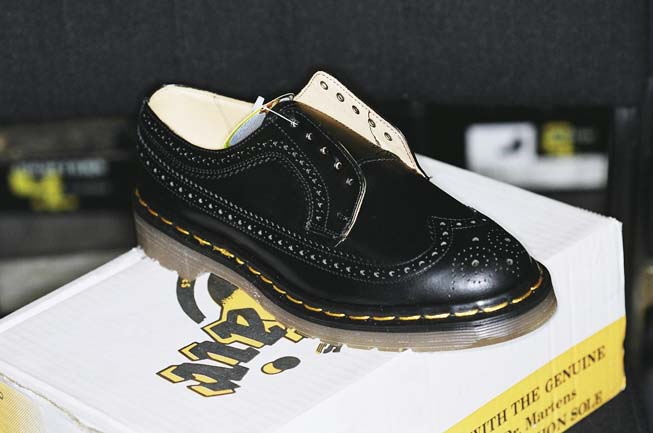 These are, of course, the Doc Martens. You can’t get these ones anymore.
These are, of course, the Doc Martens. You can’t get these ones anymore. These are suede Alfred Sargents. You see, these are English brogues. You can tell from the way that the seam drops down to meet the sole. That’s the difference between English and American brogues.
These are suede Alfred Sargents. You see, these are English brogues. You can tell from the way that the seam drops down to meet the sole. That’s the difference between English and American brogues.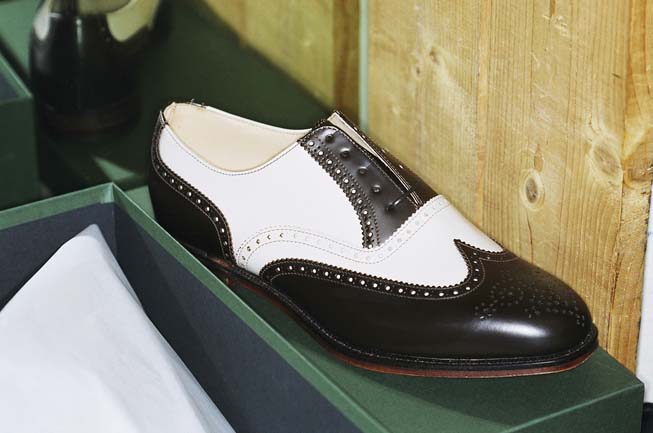 You’ll go mad for these—Alf Sargent correspondents. Your sort used to wear these back in the day. Journalists and that.
You’ll go mad for these—Alf Sargent correspondents. Your sort used to wear these back in the day. Journalists and that.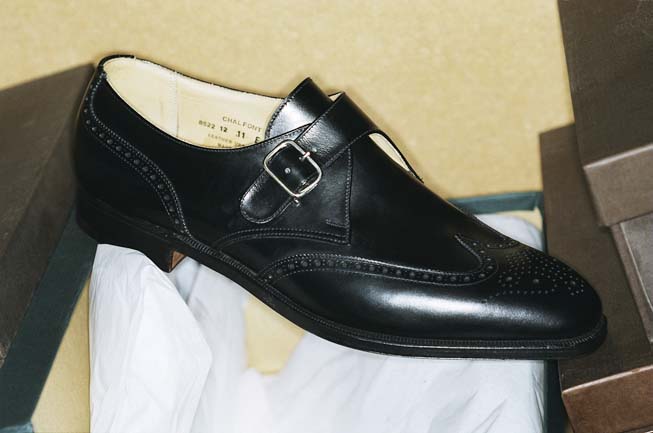 These are Crocket & Jones. They’re expensive. It can set you back around £270 for a pair of these. Still not as much as Church’s. They can be about £300. I once sold a £700 pair of casual crocodile-skin shoes.
These are Crocket & Jones. They’re expensive. It can set you back around £270 for a pair of these. Still not as much as Church’s. They can be about £300. I once sold a £700 pair of casual crocodile-skin shoes.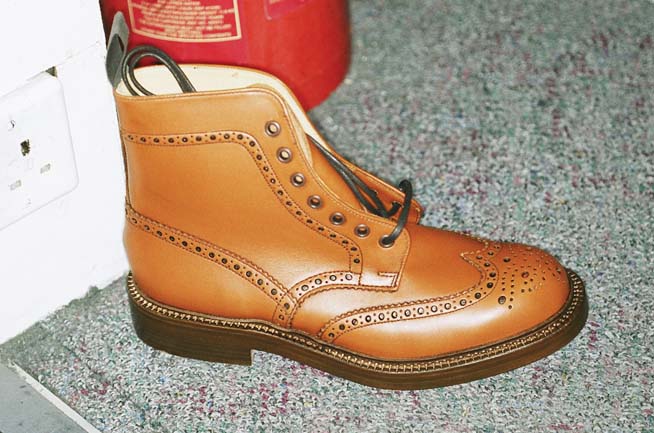 This is a classic Alfred Sargent boot, designed somewhere near the turn of the century. Brogues go back as far as 1890. They’ve dug up Romans with these on, mate.
This is a classic Alfred Sargent boot, designed somewhere near the turn of the century. Brogues go back as far as 1890. They’ve dug up Romans with these on, mate.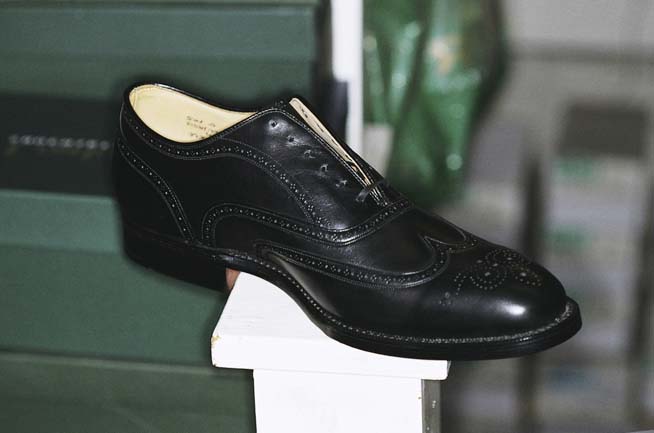 These are black Church’s brogues, the Mercedes of shoes.
These are black Church’s brogues, the Mercedes of shoes.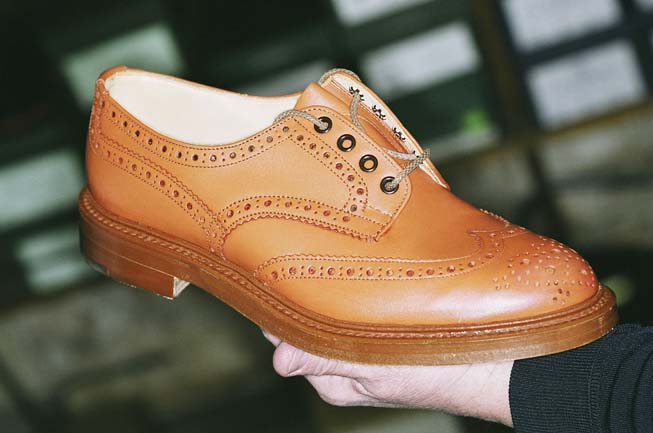 Now these are classics—Trickers. A heavy brogue. These are the ones that sell. Young people seem to like them more than the other styles.
Now these are classics—Trickers. A heavy brogue. These are the ones that sell. Young people seem to like them more than the other styles.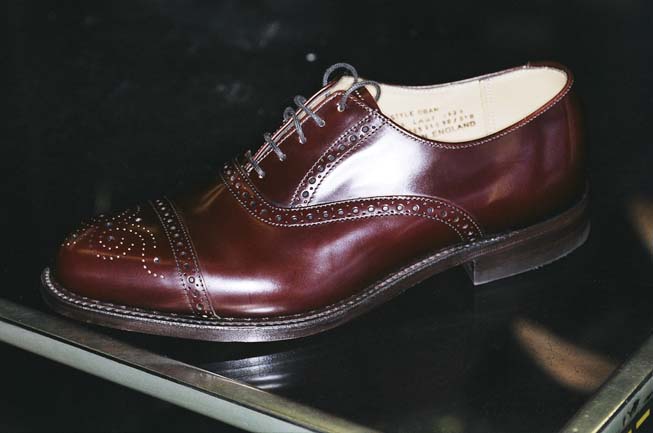 This is a semi-brogue by Loake. You can see it has less brogueing than the others. “Brogueing,” by the way, is the name for the holes in the leather. Originally they were to let water out of the shoes.
This is a semi-brogue by Loake. You can see it has less brogueing than the others. “Brogueing,” by the way, is the name for the holes in the leather. Originally they were to let water out of the shoes.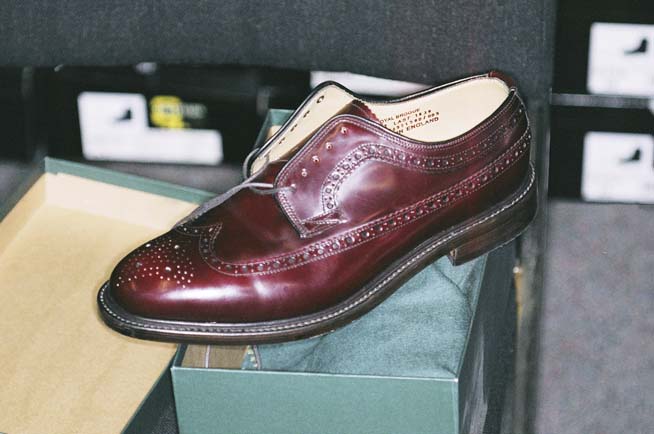 These are Loakes too. This color is called royal burgundy, but these are American brogues. You can tell they are American because the seam stays horizontal all the way to the back. It doesn’t curve down. Skinheads were into these in the old days.
These are Loakes too. This color is called royal burgundy, but these are American brogues. You can tell they are American because the seam stays horizontal all the way to the back. It doesn’t curve down. Skinheads were into these in the old days.

Advertisement
Advertisement
Advertisement
Advertisement
Advertisement




Advertisement




